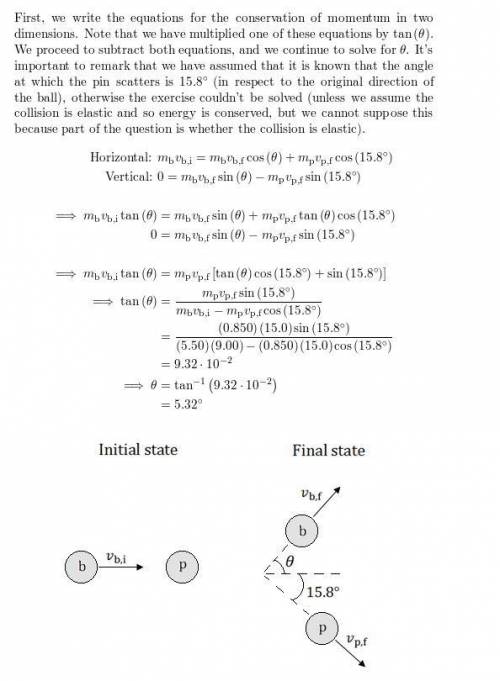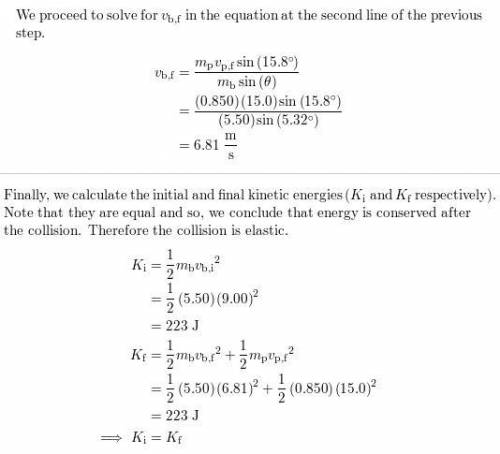
Physics, 10.03.2020 09:08 michaelmontoya68
A 5.50-kg bowling ball moving at 9.00 m/s collides with a 0.850-kg bowling pin, which is scattered at an angle of \text{85}\text{.}0º to the initial direction of the bowling ball and with a speed of 15.0 m/s. (a) Calculate the final velocity (magnitude and direction) of the bowling ball. (b) Is the collision elastic? (c) Linear kinetic energy is greater after the collision. Discuss how spin on the ball might be converted to linear kinetic energy in the collision.

Answers: 3
Another question on Physics

Physics, 22.06.2019 11:40
Imagine that you have two balloons (or, better yet, actually inflate two balloons, if possible). create static electricity around one of the balloons by rubbing it against your hair or your sweater and then bring that balloon close to the other balloon, which has not been charged. try this with at least one other object—and for variety in the discussion, avoid using an object already described by your classmates. then, for your initial post to the discussion, answer the following questions: what happened with the two balloons?
Answers: 3

Physics, 22.06.2019 12:30
When a vertical beam of light passes through a transparent medium, the rate at which its intensity i decreases is proportional to i(t), where t represents the thickness of the medium (in feet). in clear seawater, the intensity 3 feet below the surface is 25% of the initial intensity i0 of the incident beam. what is the intensity of the beam "10" feet below the surface? (give your answer in terms of i0. round any constants or coefficients to five decimal places.)
Answers: 2

Physics, 22.06.2019 15:40
Question 1 what is amperage? is the rate of doing work. is the rate of flow of protons in electric current. represents the amount of pressure behind electron flow. is the rate of flow of electrons in electric current. 2 points question 2 what is voltage? is the rate of doing power. represents the amount of pressure behind electron flow. is the rate of doing work. is the rate of flow of electrons in electric current. 2 points question 3 what is power? is the rate of flow of protons in electric current. is the rate of flow of electrons in electric current. is the rate of doing work. represents the amount of pressure behind electron flow. 2 points question 4 if we multiply volts times amps we get what? power circuit work current 2 points question 5 what are two ways alternating currents are similiar? in both ac and dc electrons flow in the same pattern. in both ac and dc, the flow of electrons changes directions back and forth. both ac and dc are only possible in certain materials with atoms that will allow electron flow. both ac and dc involve the flow of electrons. 4 points question 6 how does the flow of electrons flow in an alternating current? the flow of electrons is always slower in an alternating current than within a direct current. the flow of electrons is not constant and forward; it changes direction back and forth. electrons flow from from a higher affinity to that of a lower affinity. electron flow is constant and only in a forward direction. 2 points question 7 what is the flow like in a direct current? the flow of electrons is not constant and forward; it changes direction back and forth. the flow of electrons is constant and only in a forward direction. the flow of electrons go from a higher affinity to a lower affinity. the flow of electrons are always faster in a direct current. 2 points question 8 how is an electric current able to flow? electrons flow from the higher affinity to lower affinity and electrical current is generated. protons flow from the higher affinity to lower affinity and electrical current is generated. the movement of protons from one atom to another leads to an electric charge. the movement of electrons from one atom to another atom in a line results in a flow of electric current. 2 points question 9 how do electrons move from the two different types of metal in a battery? protons flow from the metal with the lower affinity to the metal with higher affinity and electrical current is generated. electrons flow from the metal with the lower affinity to the metal with higher affinity and electrical current is generated. electrons flow from the metal with the higher affinity to the metal with lower affinity and electrical current is generated. protons flow from the metal with the higher affinity to the metal with lower affinity and electrical current is generated.
Answers: 2

Physics, 22.06.2019 16:30
When measuring volume, why is it important to use the correct tools and units to attain the greatest accuracy? use specific examples from the lab to support your answer. (5 points)
Answers: 1
You know the right answer?
A 5.50-kg bowling ball moving at 9.00 m/s collides with a 0.850-kg bowling pin, which is scattered a...
Questions

Mathematics, 04.09.2020 20:01


English, 04.09.2020 20:01


Computers and Technology, 04.09.2020 20:01




History, 04.09.2020 20:01


Mathematics, 04.09.2020 20:01


Physics, 04.09.2020 20:01

Computers and Technology, 04.09.2020 20:01



Mathematics, 04.09.2020 20:01

Mathematics, 04.09.2020 20:01

Chemistry, 04.09.2020 20:01

Mathematics, 04.09.2020 20:01





